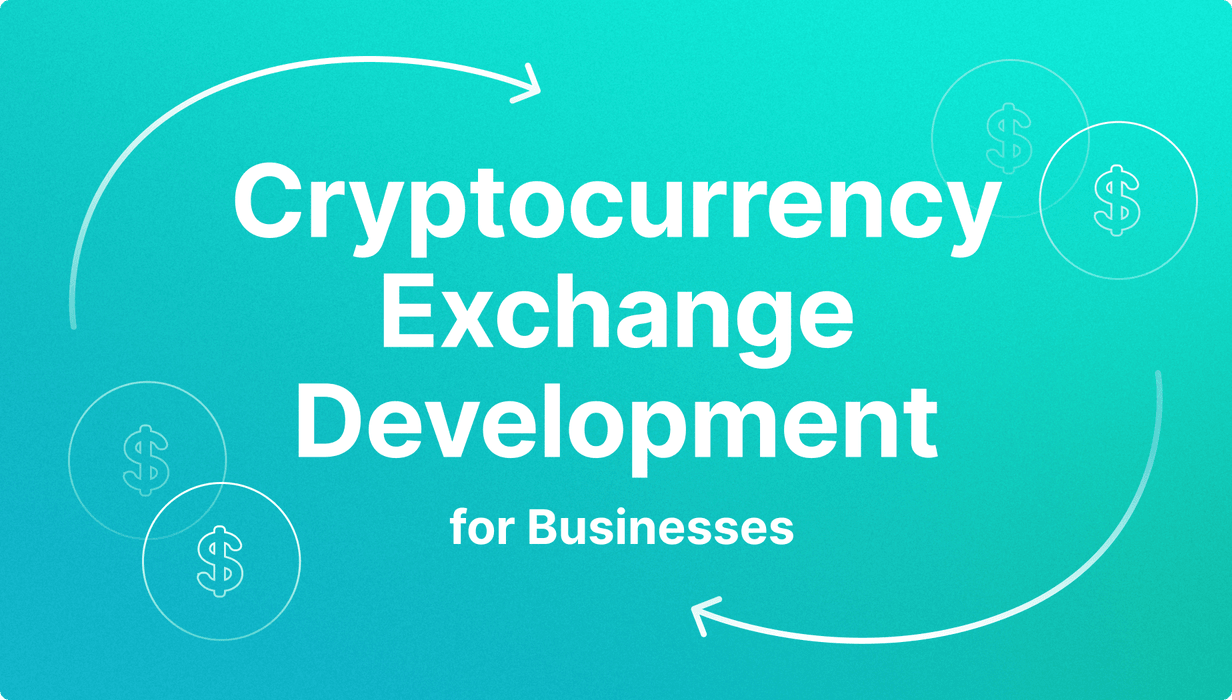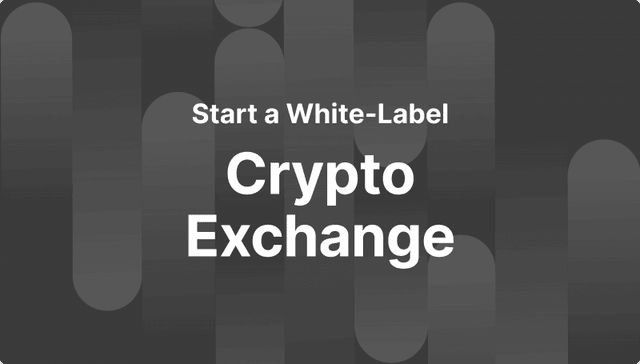The 2026 Guide to Cryptocurrency Exchange Development for Businesses

Cryptocurrency exchange platforms are crucial for any ecosystem or market that deals with digital assets, tokens, and other blockchain-based currencies. They enable participants to trade their digital holdings using advanced technology, with powerful custody and financial schemes.
Businesses that operate a crypto exchange benefit massively when more users exchange their cryptocurrencies, which happens during high volatility, speculation, economic news, and breakthroughs.
It is one of the best digital business ideas to capitalise on changing trends in this highly dynamic market. However, a cryptocurrency exchange development process requires a careful approach, from building a powerful tech stack and legal compliance to integrating security features.
In this article, we will simplify the process of launching your own crypto exchange and the decisions you need to make along the way.
Need Guidance for Your Business Setup?
From planning to execution, we provide the support you need to move forward with confidence.
What is Cryptocurrency Exchange Development?
Crypto exchange development is the process of building and deploying a platform that enables users to trade digital assets, such as Bitcoin, Ethereum, Tether, and more. It is one of the most lucrative ways to earn with blockchain technology.
However, succeeding requires careful planning and strategising on your infrastructure, technical architecture, regulatory compliance, security layers, liquidity access, and user interactions.
As cryptocurrencies continue to grow globally — take the example of BTC’s phenomenal growth between 2020 and 2025 (1,100%+) — exchanges remain a critical medium that connects buyers and sellers.

With hundreds of millions of users and institutions now participating in crypto, exchange and trading platforms handle nearly a trillion-dollar market monthly. This includes casual buyers getting their first tokens, to institutions managing complex portfolios and serving millions of customers worldwide.
To effectively develop your platform, you need to meticulously align your business strategy with technical implementation. For example, your top features, like supported coins, fiat on-ramps, fee structures, and compliance codes, must reflect the organisation’s target market and growth plans.
This way, you can build an exchange platform that leads and competes in the crypto market, and equips you with a significant competitive advantage. Some of the key considerations in the cryptocurrency exchange development process are changes in user demand, liquidity streams, tech advancements, and platform resilience.
Types of Crypto Exchange Solutions

First things first, you must select the type of crypto exchange you want to operate. You can choose a centralised, decentralised, a hybrid model, or a P2P crypto exchange. This decision changes your approach, integrated solutions, user-centric features, and other infrastructure elements.
- Centralised Exchanges (CEXs): Operated by a central authority that manages custody and order books. CEXs are known for speed, liquidity, and ease of use, but are subject to regulatory obligations.
- Decentralised Exchanges (DEXs): Interacting with smart contracts without intermediaries. DEXs offer greater transparency and user control, but are often technically challenging with liquidity constraints.
- Hybrid Models: Combine the user-friendly traits of CEXs and the autonomy of DEXs. Hybrid models offer advanced custody features while retaining efficiency.
- Peer-to-Peer (P2P) Exchanges: Offer direct transactions between buyers and sellers. P2Ps often use escrows to ensure the involved parties, which are useful in regions with banking restrictions.
How Long Does it Take to Develop a Crypto Exchange?
Cryptocurrency exchange development time varies depending on the approach you follow, whether you choose to build the platform internally or get a ready-to-use solution.
Custom development using internal teams gives you more flexibility and control over the app development phase, but typically takes more time to develop and perfect, leading to lost opportunities.
White-label solutions are faster to integrate and launch, saving money and enabling you to capitalise on ongoing trends. They offer pre-built platforms that can be customised to meet your specific needs, including features, capabilities, and scalability.
Additionally, several factors influence the delivery speed and timeline.
- Feature scope: Some functionalities take more time to finesse, such as advanced margin trading, derivatives, or crypto staking.
- Security: Stress-testing, encryption systems, custody practices, and ID verification integrations may add layers of work.
- Compliance: Licensing, KYC, and AML processes can take time to complete, delaying platform launch.
- Integrations: Connecting to liquidity providers, payment gateways, and real-time price trackers, and their alternatives, extend timelines.
Ultimately, the right timeline depends on the development approach, demanded features, and scope of work.
Development Approaches: Build, Buy, or Hybrid
The approach you use to build your platform determines the cost, control, and speed associated with launching your business. You can develop your exchange using in-house developers, external turnkey platforms, or hybrid solutions. Let’s explain how they work:

In-House Development
Building an exchange internally gives you maximum control and freedom to design bespoke features and add needed functionalities. You can oversee performance optimisation, compliance systems, and user interfaces.
However, the downside is that it usually takes more time and money. There are high upfront and ongoing costs associated with hiring experienced devs and licensing development environments. Also, building the crypto exchange software from scratch takes more time to write code, test, debug, and fix.
Finally, you need to rely on internal resources to maintain the server and offer 24/7 technical support.
White-Label Solutions
Turnkey platforms significantly shorten the time-to-market and reduce operational risks. White-label providers deliver pre-built platforms with core functionalities and typical features, which you can customise to match your needs.
Explore B2BROKER’s white-label solutions to get a fully integrated exchange infrastructure, complete with liquidity streams, wallet support, API integrations with KYC/AML providers, and trading modules.
Brokers and FinTech firms increasingly use these solutions to build quickly and scale with ease without reinventing the wheel. This enables crypto exchanges to seize current opportunities and compete with key players.
Hybrid Approaches
A hybrid solution combines the control of custom software development and the quick turnaround of white-label platforms.
As such, you can rely on internal development teams to design the core infrastructure and platform, while integrating white-label matching engines and ready-to-use payment gateways to ease your cryptocurrency exchange development process.

Ready to dive into the $3T crypto market? Learn the real cost to start a crypto exchange and unlock tips for building your platform effectively.
Core Architecture of a Crypto Exchange
A crypto exchange works through a complex architecture that ensures all instances of coin exchanges, token development, and digital asset custody work perfectly. This requires a robust tech stack that enables you to build and scale with demand, safeguard client funds, and deliver a seamless trading experience.

Here are the core components that you need to integrate.
Trading Engine and Order Matching
At the heart of every exchange lies the trading engine, which processes buy and sell orders in real time and ensures trades are executed in a timely and accurate manner. The crypto trading engine must manage the order book with minimal latency to offer fair pricing and transparent settlement.
You can integrate an aggregation engine like B2CONNECT to strengthen your liquidity practices, access more markets, and ensure stable pricing. This crypto-native liquidity bridge naturally integrates B2BROKER’s institutional-grade pricing, providing access to deep order books, competitive spreads, and smooth execution across 10+ asset classes.
Build Deep Liquidity Bridges in Days
Connect to 20+ liquidity providers, customise your order books and spreads, and launch with B2CONNECT — a crypto-native liquidity bridge built for speed and control.
Wallet Infrastructure and Custody
Safeguarding client assets is another critical pillar. Exchanges rely on a layered wallet system, including hot and cold wallets to manage user holdings.

Hot wallets are online storage that provide quick access to digital assets. They are useful for operational liquidity and exchange availability.
Cold wallets are offline storage that suit long-term custody and keep users’ funds away from the Internet for maximum security.
You can also utilise multi-signature wallets to add another layer of approval and security, preventing single points of failure. This infrastructure ensures funds remain accessible for trading and secure against cyber threats.
Security Layer
Security breaches have historically been one of the greatest risks in the industry, requiring sophisticated security measures to protect your platform.
A modern exchange must implement advanced end-to-end encryption, conduct regular penetration testing, deploy DDoS protection systems, and maintain real-time monitoring for anomalies. This proactive defence strategy builds trust with users and regulators alike.
User Authentication and KYC Modules
You need to integrate tools that verify newly registered users and maintain platform integrity. This includes identity verification systems, two-factor authentication, and fraud detection tools, which contribute to safer onboarding and ongoing protection against illicit activities.
Properly designed KYC modules not only deter criminal activity but are also required by many jurisdictions for compliance and global standardisation.
Admin Panel and Back-Office Control
To track user activities and gain crucial insights that can drive business growth, you need a solid back-office and CRM. A comprehensive dashboard allows you to monitor user activity, configure trading pairs, oversee compliance requirements, and respond quickly to potential risks.
You can access this and more with B2CORE, an integral part of the B2BROKER ecosystem and an advanced back-office system that simplifies management while maintaining enterprise-grade security.
All-In-One CRM & Back Office for Brokers and Exchanges
Fully Customisable Trader’s Room with Modular Features
Built-In IB Module, KYC, Payment Integrations, and Reporting Tools
Intuitive Interface that Boosts Client Engagement

Key Steps to Develop a Cryptocurrency Exchange
Once you have figured out the infrastructure, it is time to set a step-by-step approach to plan your entry, ensure compliance, design features, integrate features, and test the platform in real life. Here’s how you can start./
1. Define Target Market and Compliance Needs
The first step is to research the market and clearly identify your target. Make decisions about geographic reach, user segmentation, asset offerings, and trading products, and how you can manage each of them.
This aids in shaping the exchange’s licensing requirements, needed features, and competitive positioning. This stage is necessary to make the right offering that suits the target market, understanding current service gaps and avoiding common pitfalls.
2. Secure Licensing and KYC/AML
Licensing is necessary to instil confidence in your clients and operate legally. You must set up an experienced legal counsel to prepare the necessary documentation and navigate regulatory frameworks.
After acquiring the license, you must integrate KYC and AML systems according to the jurisdiction’s guidelines, including identity verification, transaction monitoring, fraud detection software, and ongoing screening.
3. Design the Trading Engine and Wallet Systems
Ensure a powerful trading engine is in place. Ideally, it must be engineered for high throughput, low latency, and uninterrupted uptime. Then, you can configure financial settlements and automation capabilities.
Besides that, you need to establish wallet systems, including cold and hot storage and multi-sig crypto wallets, to have a solid asset management and minimise unauthorised access to funds.
4. Integrate Liquidity and Payment Gateways
Liquidity is key for any crypto exchange platform, and maintaining high streams engages top-tier DeFi investors and institutional clients. It also equips you with competitive spreads and low exchange costs that attract more retail users and increase trading volume on your platform.
Integrate with liquidity aggregation solutions, market makers, and payment gateways to ensure a frictionless user experience across the board.
5. Test, Deploy, and Optimise
In the final step, you need to thoroughly test your platform. This includes unit and integration testing, security breach testing, and load testing under stress conditions.
You can also roll out a soft launch by releasing your product to selected users and early investors, who can test the platform and report on any bugs or shortcomings. This enables you to fix any issues without causing major service interruptions.
Finally, deploy your exchange with strong security audits, customer assistance, and active liquidity connections. Make sure you continuously optimise your platform to refine features and keep up with the latest cryptocurrency market developments.
Legal and Compliance Requirements
No matter how advanced your exchange’s architecture is, regulatory compliance determines whether an exchange can operate legally or not. You must carefully understand the legislation of the jurisdictions governing your business and adapt accordingly.
In the US, crypto exchanges face one of the most complex regimes. Platforms that act as “exchangers” or “administrators” of digital assets are treated as money services businesses, making registration with FinCEN compulsory. Moreover, most states impose their money-transmitter licensing protocols, such as New York’s BitLicense.
Additionally, depending on whether the assets fall under securities or commodities law, exchanges may also come under the jurisdiction of the SEC or the CFTC, adding another layer of oversight.
Across the European Union, the Markets in Crypto-Assets (MiCA) framework creates a single authorisation process for crypto-asset service providers, enabling passporting across all member states.
As such, firms must comply with EU anti-money laundering rules stemming from the Anti-Money Laundering Directives that shape criminal liability and uphold obligations under the GDPR for data protection.
When it comes to Asia-Pacific markets, the regulatory picture is diverse.
- Singapore requires obtaining a licence under the Payment Services Act 2019, with the Monetary Authority of Singapore overseeing AML and consumer protection.
- Japan mandates registration with the Financial Services Agency for crypto exchange providers, supported by the self-regulatory JVCEA.
- Hong Kong requires mandatory licensing for virtual asset trading platforms under the Securities and Futures Commission since 2023.
- South Korea enforces strict AML standards, requiring exchanges to implement real-name bank accounts and robust KYC procedures.
Given the complexity of some of these jurisdictions and regulatory bodies, you should expect compliance timelines to include the preparation of applications, the implementation of compliance systems, regulatory review periods, and final approvals. These stages can lead to various delays.
B2BROKER’s Turnkey Solutions for Crypto Exchange Development
If you are looking for a faster and safer entry into this dynamic market, B2BROKER’s turnkey crypto exchange solution is the best choice, backed by years of industry experience and adoption by top-tier market players.
This solution reduces technical risks, provides fully compliant frameworks, supports deep liquidity streams, and integrates features that every exchange needs.
Build and scale your cryptocurrency exchange in a few days with B2BROKER!
Build a Global Crypto Exchange with Confidence
Benefit from 10+ years in the crypto space and 1,000+ clients, paired with a high-performance, compliant turnkey solution built for scale.







